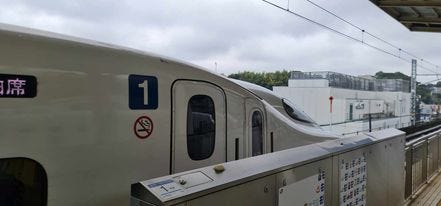The Japanese bullet train is famous world over as a futuristic way of travelling between cities. Train nerds will travel by plane just to visit the Shinkansen and marvel at the speed. It has been a feat of engineering admired by almost all tourists who travel between cities at great speeds. This train triumph is impressive, but within the bullet trains’ uniqueness lies a troubling question. The very same question we asked about Japan’s toilets.
Welcome to another edition of the Galápagos Syndrome, where we look at some of Japan’s best inventions and ask: why only in Japan?
A Begging Solution
High speed rail has been touted as a panacea solution to wealthy countries for decades. Everyone has had proposals, plans and ideas of how to connect their major cities by land away from roads, no matter how absurd the proposals are. Now, there are many problems to solve when creating a complex network of trains. This has been evident in the astronomical cost blowouts for still-unbuilt routes such as San Francisco to Los Angeles (and beyond?), and London to Manchester.
This is not a concern in Japan. The OG gurus already built their network, and despite salivating foreign transport ministers, it’s not like anyone can just steal it. So how did Japan build it in the first place?
History of the future
While bullet trains might seem like an impossible future dream for many in the 21st century, it’s actually quite an old technology. 2024 will mark 60 years since the very first Shinkansen took flight (metaphorically speaking). For context, the Shinkansen was introduced to the world the same year as colour television.
The Tōkaidō Shinkansen travelled between the three megacities of Osaka, Nagoya and Tokyo and was an instant success (replacing the Old Tōkaidō Road described in a previous post).
It helped with everything a government is worried about: it improved the economy, helped the environment, even helped strengthen national security! The direct economic benefits came from drastically reducing travel time for commuters and meant Osaka-Tokyo was able to be a day trip (very helpful for business types). More train commuters meant less car drivers and would directly lessen CO2 emissions for equivalent trips (although not a concern at the time). Fewer cars driven lessen reliance on imported oil, a concern Japanese security has held since the start of the slippery commodity.
Little wonder that the Japanese government saw these outcomes and thought, “let’s build much more of this!” The government got overexcited and built rail up and down Japan in a frenzy, laying down track first to cities which made money back, then to towns, then to sparsely populated rural areas, all in the desire to connect.
With a bullet train in every backyard, the national railway went bankrupt on its train building addiction and got privatised into a group of seven companies, collectively known as the JR Group. These guys still build trains, but have now learnt their lesson and keep a cursory eye on the budget.
All this to say that the Shinkansen has become an integral and highly valuable part of Japanese life. Yes, there have been instances of overspending and complaints about noise, but the overarching sentiment is that the Shinkansen was the tank engine that turbocharged Japanese industry for half a century.
Looking at all this success, it’s no wonder that every major country is jealous of this marvel of a train network. Yet that actually poses the main problem for Japan.
Why is everyone building (or attempting to build) high speed rail without Japan’s help?
Where are the train builders
Privatisation is not to blame for lack of interest in Japan’s assistance. Turns out that even a well-regulated company with governmental oversight can make the trains run on time (without being an excuse for fascism). The JR group has managed to continue the tradition of maintaining Japanese excellence in train engineering. They have the technology, proven it works, and they are willing to share it.
With no foreign train network budgets coming in at a reasonable cost, it’s fair to ask… Why not ask JR?
Given the enormity of these projects, most countries will try to build their own first. That’s pretty in line with election promises that these trains build jobs (rather than jobs building trains) When push comes to shove though, trains that transport millions of people each year might be an area requiring expertise.
Both the UK and US realised this and booked outside help. The call went out to all train makers. Following every train enthusiast on the planet putting in a tender, the Brits chose a conglomerate of companies based in Sweden, Austria, France, and UK. Meanwhile, the Americans still haven’t finalised their decision despite the project already over schedule (but are comparing proposals from Germany, China, Spain, Italy, and USA).
If you’re as keen-eyed as the Japanese government, you might have noticed a conspicuous absence. Where’s Japan?
Galápagos strikes again
As tempting as this would be to chalk up to the Anglosphere being Anglo, the shunning of Japanese trainspertise isn’t unique to these two countries. From Thailand to Germany to South Korea, anyone who has tried building bullet train systems has emulated Japan but not employed Japanese firms.
The primary reason is that very fast trains are very expensive. This rules out many countries from building trains at all, leaving the next government with mounds of feasibility reports. Of the remainder who actually have the dough, the Japanese systems are still much more expensive than everyone else. How can this be?
Well, as per the Galápagos syndrome, the Shinkansen is much like a Japanese toilet (in the best way possible). The Shinkansen is a luxury product that is a clear upgrade on existing products. However, to function properly, it needs additional electrical networks, a broad cultural acceptance, and costs a lot more. But once you use it, there is no going back.
For countries considering JR’s offering, the only option is buying the whole train network. That means rails, electrical network, software, and trains. It commits a country to JR’s maintenance fees, schedules, and a single way of doing things. This is not something that comes naturally to transport boards or committees. They seem to prefer the many hands in the kitchen approach, never seeing a consultant that wasn’t worth adding to the team.
JR’s closed off system has meant a flourishing of high speed rail at home. However, the pesky foreign buyers requesting proposals keep asking for features to integrate the rail into their existing rail network. From innocuous requirements like the trains needing to run on the right side of the tracks, to refusing the use of any other rail for Shinkansen, the inflexibility of the JR Group finds them out in the cold for foreign country tenders.
This gap just doesn’t seem to be reconcilable. The Japanese opinion holds merit, given they are the experts. There are a myriad of benefits from implementing a whole scale closed network: running many more trains (one every four minutes, as opposed to Europeans which are at best once an hour); an unbeatable safety record of zero passenger injuries over nearly 70 years; and some even claim that the Shinkansen system is cheaper in the long-term despite a much higher upfront cost, with lower operational and maintenance costs.
The refusal to budge in the face of any customisations or changes is not necessarily a virtue, either. The task of constructing a mega-billions high-speed rail is already a tough sell to voters. Especially to the millions who won’t or don’t travel between cities regularly. Imagine telling them that this new rail line also can’t be connected to all the other lines we’ve spent other billions on. It’s just going to be its own special network sitting by itself. It’s an especially tough thing to stake a reputation on, when there are countless other cheaper and often faster competitors from China and Europe.
Silver Bullet
So, is this the end state of Japanese rail? Just continue to maintain and upgrade internally, until the very outer edges of the Japanese coast are only a train ride away?
Well, some Japanese companies have bitten the bullet and decided that if you can’t beat them, join them. Hitachi, for instance, has formed a joint venture with French Alstom to finally win a bid in the UK’s HS2. Of course, this meant Hitachi had to ditch the closed system idea still so popular back home. As a sign that Hitachi is serious about not just focusing inwards, they even constructed their first ever factory in Europe in 2015.
Hitachi’s approach shows a way forward for Japanese industry. Instead of insisting on selling their product as an entire system, maybe the best approach is to compromise by finding a local partner who can help with the modifications and navigating local regulations.
It turns out you can have your cake and eat it too. High quality work is possible if you have someone familiar with your country of interest. That’s why you should subscribe to Hidden Japan. It brings you insights beyond the norm.








Yeah, speaking as a native Californian, I remember when those proposals were first introduced for train between SF and LA, and still nothing has happened apparently—it will never happen—not least of which because public transit is anathema to the vast majority of Americans, total pipe dream. I took the shinkansen in Japan only once when I was there. My thoughts were: very fast, very expensive, rain drops condensing horizontally onto the windows very quickly.
Beautifully written. Very impressed with the analysis here.